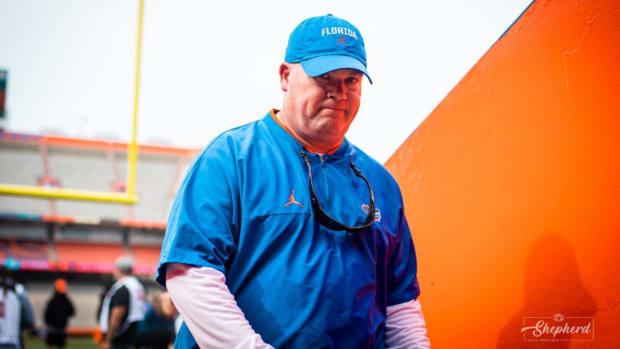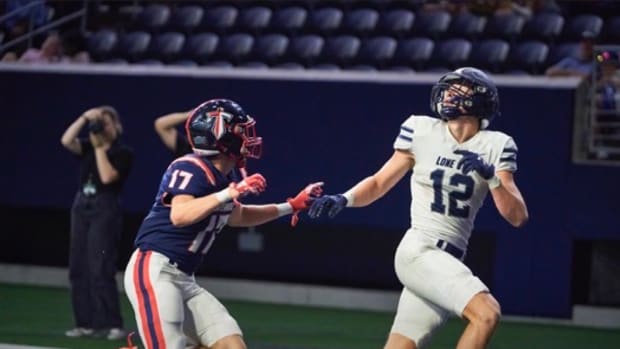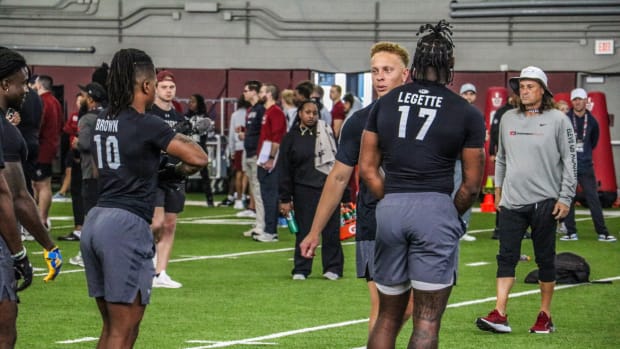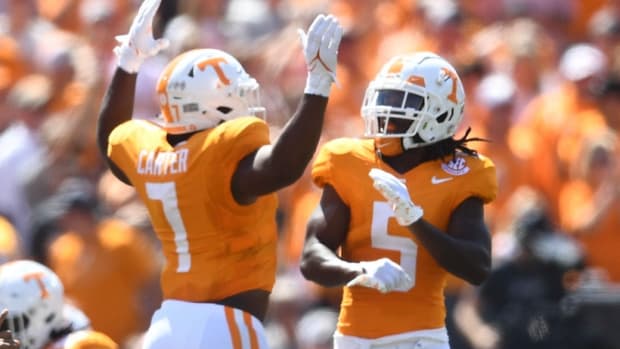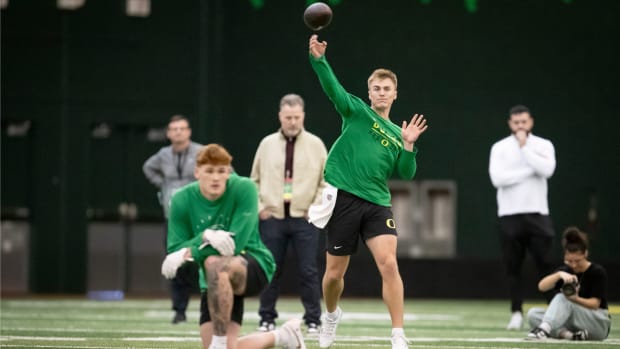Recruiting's Biggest Week Has Arrived Quietly, and Almost Everyone Involved Is Thrilled
Admit it. It snuck up on you again this year again, didn’t it?
On Wednesday, nearly all of the football programs in the Power 5 and most of the programs in the Group of Five will sign the bulk of their 2019 recruits when the early signing period begins. The first early period last year eliminated much of the circus aspect of the February signing date, and the second edition of the early period will arrive this week without much fanfare, which is how college coaches and most recruits would prefer it.
Only truly serious recruitniks have been gearing up for this week; the bulk of college football fans have been too busy watching games. So while National Signing Day may have ended as a national college football holiday, it has become more manageable for coaches who would have been recruiting now anyway.
Some coaches wish the rule had changed earlier. Matt Rhule would have appreciated having the early signing period as an assistant coach at Buffalo near the turn of this century. Rhule, now the head coach at Baylor, was a 24-year-old position coach in central New York when he brought in a junior college player on an official visit. At the time, schools were allowed to show recruits’ highlights on the scoreboard. As Rhule and the player watched the highlights roll, the recruit spoke. “Hey, Coach. That’s not me,” Rhule remembers the player saying. “That’s No. 5. I’m No. 6.”
Rhule had invited the wrong player. Now, such a moment probably would be followed by an unpleasant conversation that would be somewhat ameliorated by the fact that even if the official visit weekend was near the December signing date, the player still would have six additional weeks to find a school.
Rhule can laugh now about his lowest recruiting moment. He still doesn’t enjoy uncomfortable conversations any more than he did then, but he does prefer the way the December signing period strips some of the double-talk from the recruiting process. “I like the early signing period,” Rhule says. “It brings reality. You can say you have an offer. You can say you’re committed. But it means a whole other thing when both parties sit down and sign on the dotted line.”
That is indeed the best thing that came from the rule change that took effect last year. When players are allowed to sign beginning Wednesday, they’ll know if they really had a scholarship offer from the school they’d committed to because that school will have sent a financial aid agreement and a National Letter of Intent to sign. Coaches won’t be able to play the “non-committable offer” game to string along second-option players, and recruits won’t be able to claim they’re committed if they’ve declined to put pen to paper when given the chance.
Coaches adjusted fairly quickly when the rule changed in 2017, and this year it felt as if they’d been recruiting with this cycle for decades. “We’ve taken the approach that we’re going to try to sign as many guys as we can in December,” Rhule says. “We’ll take a break. We’ll sit back and whether we have one, two or three scholarships left, go out in January and try to identify any special needs or any special players out there.”
That seemed to be the prevailing method last year. Some extremely high-profile recruits wanted to wait until February to sign, so some major programs had to keep slots open. But for the most part, the January period—during which coaches are allowed to visit high schools—was used for working on the next two or three classes. “Nowadays,” Wisconsin coach Paul Chryst says, “it seems like you’re recruiting three classes all the time.”
NIESEN: Grading the 21 Biggest Moves of the 2018 Coaching Carousel
Rhule has used that time to meet people. He doesn’t need to watch much video of recruits. He can pull up video of practically any workout he wants thanks to programs such as HUDL and eager parents and recruits who post camp workouts alongside game footage on the Web. What he can’t do most of the time is visit high schools. That’s critical as the former Temple coach adjusts to coaching at a school that draws most of its players from a talent-rich 250-mile radius around Waco. “I want to go into the schools and meet the counselors and meet the principal and meet the coaches and just continue to build relationships,” Rhule says. “To me, that’s really the way to recruit if you’re a team like us that wants to be regional and local.”
The new rule Rhule has chosen not to take advantage of much is the one that took affect this year allowing for early official visits. Previously, recruits couldn’t take an official visit until after Sept. 1 of their senior year of high school. Beginning this year, recruits also could take official visits beginning April 1 of their junior year of high school and into June before the window opened again in September.
Baylor has 18 players committed, according to 247Sports, and none of them took early official visits. They also didn’t take official visits during the season. That was by design. Fourteen of those 18 committed players took their official visits either the weekend after the regular season ended (the week of conference title games) or the following weekend. “We learned a lot last year,” Rhule says. “I liked the old recruiting model in terms of the official visit after the season.”
That works at a school surrounded by desirable recruits. Players from the Dallas, Austin or Houston metro areas can easily drive to Baylor nearly anytime, meaning they can make an unofficial visit (a trip not paid for by the school) for a relatively low cost. Even though it recruits about the same level of player as Baylor according to the recruiting service ranking models, Chryst’s Wisconsin program has to employ a different strategy. For the Badgers, who plan to sign players from at least 12 different states on Wednesday, the early official visits proved incredibly useful.
Ten of Wisconsin’s 19 committed players made official visits in June. The highest ranked players in the class (five-star offensive lineman Logan Brown, four-star quarterback Graham Mertz and four-star offensive lineman Joe Tippmann, all visited on the weekend of June 8–10. Chryst says the lighter class schedules for current players during the summer allow them to get to know the recruits better and help sell the program. “Our players enjoyed it,” Chryst says. “They felt like they had more time and more relaxed time.”
That relaxed time in June has led to a more relaxed December. There certainly will be some dramatic moments for some programs this week. And there may even be a few controversies. Last year, Clemson coach Dabo Swinney had to answer questions about his recruiting pitch when Jackson Carman, Ohio’s top-rated prospect in the class of 2018, said Swinney had told him Ohio State coach Urban Meyer was on the back end of his career. Swinney didn’t deny saying that, and that led to some anger in Ohio. But Meyer is about to coach his final game for the Buckeyes in the Rose Bowl on Jan. 1, so it turned out Swinney was correct.
But all in all, the real National Signing Day for the class of 2019 probably will be as orderly and (un)eventful as the real National Signing Day for the class of 2018 was last December. And that’s exactly what the coaches and the recruits were hoping for.
Five-Star DE Kayvon Thibodeaux Picks Oregon Over Alabama
A Random Ranking
Reader David Fox pointed out this disturbing fact:
Know what that means? Yes, we probably should worry about becoming a dystopia where the top-rated television show features multiple straight-up murders each week. But more importantly, we need to honor the best performance in The Running Man (Richard Dawson as Killian) by ranking the best Family Feud hosts.
The top six answers are on the board. Survey says...
1. Richard Dawson
2. Steve Harvey
3. Ray Combs
4. Louie Anderson
5. Richard Karn
6. John O’Hurley
Three And Out
1. Tennessee and Florida State will head into Wednesday’s signing day without offensive coordinators. A host of programs with new head coaches will go into Wednesday without full staffs. Do you really think every one of those jobs is actually open right now? If you do, I have a bridge to sell you. As orderly as the early signing period seems to be, it hasn’t eliminated one day that produces hurt feelings everywhere: Moving day.
That’s the day when all the assistant coaches who have agreed in principle to other jobs but who have stayed where they were to finish out the recruiting class announce that they’re moving on to new jobs. Thanks to the early signing period, that day has moved from the first Thursday in February to the Thursday before Christmas (though it isn’t a hard and fast date because some coaches may go a few extra days and finish their bowl games).
So even if Wednesday’s signing date passes without much drama, get ready for a few fireworks shortly afterward.
NIESEN: The Most Important Coordinator Moves of the Offseason
2. Though he has one more game as North Dakota State’s head coach—the FCS national title game against Eastern Washington—Chris Klieman is about to make the FCS-to-FBS jump when he takes over at Kansas State. SI’s Ross Dellenger talked to coaches who have made the move to learn about the “complicated” process of moving up a division. The good news? No hogs on the practice field in the FBS.
3. No one celebrates wins quite like Georgia Southern coach Chad Lunsford. And Lunsford got some help following Saturday’s thrilling 23–21 Camellia Bowl win against Eastern Michigan from country music star and former Georgia Southern student Cole Swindell.
What’s Eating Andy?
For those who would like a College Football Playoff that uses a common-sense bracket, features games on campus and makes conference championship games more important and more exciting, some of the comments from around college football last week seemed promising.
And while an eight-team playoff probably is inevitable, it is anything but imminent. The twin tasks of getting the people in charge of college sports to agree on something and revising an existing TV deal are going to take some time. Perhaps it won’t be until the end of the current deal—which has seven more years after this one—or maybe it will be after another cycle through the current semifinals. But despite all of our excited chatter here and on the radio, don’t start making your quarterfinal weekend plans for the next few years. You may just have to be happy with the Las Vegas Bowl and the Camellia Bowl on that Saturday for a while.
What’s Andy Eating?
The Loyola-Chicago basketball team may not be headed back to the Final Four this season. The Ramblers have lost to Nevada, Boston College, Maryland, Ball State and Furman (on the rare buzzer-beating poster dunk). It will take a special January and February to recapture the magic in time to win the Missouri Valley Conference Tournament—which would be the Ramblers’ only realistic path back to the NCAA Tournament.
But no matter what happens this season, Loyola-Chicago players and their fellow students can take solace in the fact that some of America’s best wings are only a five-minute walk from campus. Dak is an unassuming Korean joint in Chicago’s Edgewater neighborhood. This family restaurant—run by two first-generation American brothers and their Korean immigrant parents—serves up huge, crispy, juicy wings thinly covered in a soy-garlic sauce that feels designed to make the taste buds crave more wings.
My two favorite wings in America before tasting Dak’s wings came from Pok Pok in Portland and Minero in Atlanta. Those places come at the wing from very different places. Pok Pok doesn’t aim for paper-thin skin like Dak does, but Pok Pok’s Vietnamese fish sauce has similar addictive effects (despite a different taste) to the Dak sauce on those beautiful wings in Chicago. Minero’s wings are grilled and then tossed in Valentina hot sauce. Their appeal lies more in the interplay between the charred skin, juicy meat and spicy sauce.
That’s the beauty of the wing. I don’t have to pick a favorite, because there are so many ways to make it great. I can love the wings at Dak, at Pok Pok and at Minero. I can also love the smoked wings at Saw’s Soul Kitchen in Birmingham, Ala., and the coal-oven baked wings at Anthony’s, a chain that started in South Florida but has moved up the Eastern Seaboard.
But when I visit Chicago—or nearby Evanston—I’ll need to get back to Dak. When I visited, I ordered 10 wings thinking I’d have a light lunch. (And thinking the wings might be a tad pricey.) Then I realized that one wing to Dak is the same as one wing to the chicken. While most places count the drum and the flat as one wing each, Dak counts the entire apparatus as one. That meant I had ordered considerably more than I intended. (And it meant the wings were actually a bargain at $12.95 for five.) The wings are fried first in a regular fryer and then dropped in a pressure fryer, sealing in the juices and creating crunchy skin that feels impossibly thin. The wings aren’t drenched in that soy-garlic sauce, either. It feels painted on, and it blends just the right touches of salty, spicy and sweet. Too much of that sauce might be a turn-off, but it feels as if the actual mom and pop in the kitchen are doling out just enough to make you need that next wing.
That’s how I felt after each one, and before I knew it, that pile of wings was a pile of bones.

